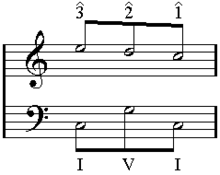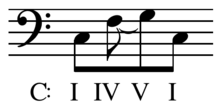Prolongation
In music theory, prolongation is the process in tonal music through which a pitch, interval, or consonant triad is able to govern spans of music when not physically sounding. It is a central principle in the music-analytic methodology of Schenkerian analysis, conceived by Austrian theorist Heinrich Schenker.[1]
Prolongation can be thought of as a way of generating musical content through the linear elaboration of simple and basic tonal structures with progressively increasing detail and sophistication.[2] Important to the operation of prolongation is the hierarchical differentiation of pitches within a passage of tonal music. Typically, the note or harmony of highest hierarchical significance is the tonic, and this is said to be "prolonged" across durations of music that may feature many other different harmonies. (However, in principle any other type of consonant chord, pitch, or harmonic function can be prolonged within tonal music.) Conversely, in a chord progression, harmonies are said to prolong a triad when they are subordinated to that governing chord in a systematic manner; the job of such prolonging harmonies is to express and extend the influence of that hierarchically super-ordinate pitch or triad.[3] Because it enables a pitch or pitches to remain in effect over the course of a piece, even as many other harmonic events intervene, prolongation is central to the concept of tonality in music.
Prolongation in Heinrich Schenker
The early 20th-century music theorist Heinrich Schenker (1868–1935) was responsible for developing both the conceptual framework for prolongation and a means of analyzing music in terms of prolonged musical structures (called Schenkerian analysis).
Schenker’s own usage of the term differs from the modern one. The German word Prolongation is not common, and Schenker first used it in a very specific meaning (maybe originating in legal, possibly Viennese vocabulary), referring to the extension of the primal laws (Urgesetze) or of the primal concepts (Urbegriffe) of strict composition in free composition[4] and the phenomena resulting from the extension of these laws.[5] He used the word mainly to denote the transformation of a given level of voice-leading to the next one, describing the passage from level to level as a Prolongation. Adele T. Katz appears to be responsible for the shift of meaning where "prolongation" became the American translation of Auskomponierung, "elaboration".[6]
In his analysis of J.S. Bach's Little Prelude in D minor, BWV 926, in Der Tonwille 5, Schenker proposes what may be his earliest figure showing the steps through which the Ursatz develops into the foreground. He explains that this figure "shows the gradual growth of the voice-leading prolongations, all predetermined in the womb of the Urlinie".[7] The "gradual growth" illustrated is a global phenomenon, always concerning the piece as a whole. The figure is further commented upon on p. 45 of the same volume. Schenker stresses that it starts with the two-voice setting of the Ursatz – an expression, therefore, of the fundamental laws of strict counterpoint. Each of the following steps is described as a Prolongation, a specific freedom taken with respect to the laws expressed in the previous step. And in Freie Satz, he confirms that the word still refers to the passing from one voice-leading level to another: "For the sake of continuity with my earlier theoretical and analytical works, I am retaining in this volume the words of Latin derivation Prolongation and Diminution as designations for the voice-leading levels in the middleground".[8]
The concept of Prolongation is important for Schenker because he believes that showing how a masterpiece of free composition remains rooted in the laws of strict counterpoint explains its utter unity, its "synthesis".[9] The means and techniques of passing from one level to the next are subsumed in Schenker's notion of "composing out" or "compositional elaboration" (Auskomponierung, a German neologism), which for him is a mechanism of elaborating pitch materials in musical time.[2] The means of elaboration are described below as "prolongational techniques", in conformity with the modern Schenkerian English usage, but should better be termed "elaborations".
The broadening of the meaning of "prolongation" has been described by Anthony Pople[10] in seven steps: (1) Schenker proposes it as an operational concept in his teaching; (2) Salzer,[11] Forte[12] and others, disseminate and clarify it; (3) it is used within attempted formalisations of Schenkerian analysis;[13] (4) new theories evoking Schenker[14] make use of it; (5) it is used within theories amplifying Schenker's own;[15] (6) definitions are proposed in theories beyond the Schenkerian canon;[16] and (7) definitions of the term are proposed in relation to atonal music.[17] The replacement of Schenker's own term Auskomponierung by "prolongation" appeared in step (2), as an English translation.
Prolongational techniques

In Schenkerian analysis, the analyst discerns ways in which prolongation creates the details of a musical composition by elaborating the background structure. Most of these methods involve contrapuntal processes, to such a degree that Schenkerian theory is a theory that almost completely synthesizes harmony and linear counterpoint in the service of the more global phenomenon of tonal prolongation. Prolongational techniques include arpeggiations, linear progressions, unfoldings, etc., in general aiming at the horizontalization, "the elaboration in time of a governing vertical sonority – a chord or an interval. [...] When an interval is horizontalized, its tones unfold against a background determined in the vertical dimension by the governing sonority of which it is part."[21]
Conditions for prolongation
Schenker intended his theory to apply only to music of the common practice period, and there to a select class of mostly Austro-German composers in a line from J.S. Bach to Johannes Brahms. Developments in more recent music theory have sought to clarify the conditions under which prolongation may obtain, so that other repertoires may either be opened up or more justifiably be precluded. Schenker pupil Felix Salzer, for example, detects the rudiments of prolongational horizontalization in music as early as 12th-century plainchant and argues that it is a musical principle that persists through post-tonal music as well, such as Paul Hindemith and Igor Stravinsky.[22] Music theorist Robert Morgan has argued that a central tenet of Schenkerian thought—that only consonant triads are capable of prolongation—needlessly excludes a class of dissonant sonorities, such as diminished sevenths or a more arbitrarily defined set of pitches; Morgan claims that, starting in the 19th century, composers such as Liszt, Wagner, and Scriabin, began "composing out" these dissonant configurations as rigorous a manner as is usually ascribed to the triadic prolongation of tonal composers.[23]
Atonal music poses a stark challenge to prolongational hearing and analysis, as its harmonic makeup by definition eschews the long-range controlling force of monotonality, and in most cases purposely abstains from consonant triads, or indeed referential or centric sonorities at all. Music theorist Joseph Straus has attempted to define more rigorously what it is about atonality that precludes prolongational hearing. His own definition of prolongation is "the sense of continuation of a musical object, particularly when not literally present ... prolongation is a cognitive act of the listener".[24] He formulated four conditions for the possibility of Schenkerian prolongation in any musical style (1987)[25] These are:
- Consistent distinction between consonance and dissonance.
- A scale of stability among consonant harmonies [see diatonic function].
- Ways in which less structural pitches embellish more structural pitches.
- A clear relationship between harmony and voice-leading.
Straus concludes that such conditions do not exist in atonal music and therefore that "atonal prolongation" is impossible. However, theorist Lerdahl argues that Straus' argument is based on circular criteria.[26] Lerdahl's own formulation of prolongation is more amenable to atonal structures. For example, in atonal music, strong prolongation may be distinguished from progression, repetition of an event versus movement to a different event, while weak prolongation, repetition of an event in altered form, may not easily be distinguished due to the lack of a referential triad (klang).[27]
Sources
- "It is one of the most valuable services of Schenkerian theory to have revealed for the first time the unity of composing-out and the prolonged application and validity of the laws of voice leading." Oswald Jonas, Introduction to the Theory of Heinrich Schenker, trans. John Rothgeb (New York: Longman, 1982), p. 54.
- William Drabkin. "Prolongation." Grove Music Online. Oxford Music Online. 2 Aug. 2011 <http://www.oxfordmusiconline.com/subscriber/article/grove/music/22408>.
- Salzer, Felix (1962). Structural Hearing: Tonal Coherence in Music, p.111. ISBN 0-486-22275-6.
- For instance when he explained that the task of the study of counterpoint is to reveal how its fundamental laws can be extended to apply to free composition: "But to reveal the basic form together with its variants, and [thereby] to uncover only prolongations of a fundamental law even where apparent contradictions hold sway – this alone is the task of counterpoint!" Kontrapunkt I (1910), p. 315; English translation (1987), p. 241. See also J. Dubiel, "When You are a Beethoven: Kinds of Rules in Schenker's Counterpoint", Journal of Music Theory 34/2 (1990), p. 293, and R. Snarrenberg, "The Art of Translating Schenker: A Commentary on 'The Masterwork in Music,' Vol. 1", Music Analysis 15/2-3 (1996), p. 324.
- Schenker claims among others that three-voice counterpoint is subject to the same laws as two-voice counterpoint, of which it represents a "Prolongation": "In three-voice settings, the [laws of] two-voice settings actually continue to apply; three-voice setting therefore represents merely a prolonged phenomenon". Kontrapunkt II (1922), p. 1; English translation (1987), p. 1.
- Adele T. Katz (1935). "Heinrich Schenker's Method of Analysis", The Musical Quarterly 21/3, pp. 311-329. This conception of "prolongation" may have its origin in the teaching of Hans Weisse.
- Der Tonwille 5 (1923), p. 8, Fig. 1; English translation (2004), p. 180. Later in the same volume, p. 33 (transl., p. 202), Schenker describes a similar figure as showing "the succession of prolongations, that is, the layers of the voice-leading."
- Der freie Satz, 2d edition (1956), § 45, p. 57; English translation (1979), p. 25.
- Deriding the lack of the "art of prolongation" in Bruckner, he writes "his ear could not hear the beginning and end of a motion as an entity. The two points remain without inner relationship to one another; and everything shoved and squeezed in between, though executed with so much art on an individual level, exhausts itself purely physically without any concern for connection." Der Tonwille 5, p. 46; English translation, p. 213.
- Anthony Pople, "Using Complex Set Theory for Tonal Analysis: An Introduction to the 'Tonalities' Project", Music Analysis 23/2-3 (2004), pp. 162-164. Pople describes "prolongation" as "a Humpty-Dumpty Word".
- Structural Hearing, 1952/1962
- 1959: "Schenker's Conception of Musical Structure", Journal of Music Theory 3/1, 1959.
- e.g. Forte and Gilbert, Introduction to Schenkerian Analysis, 1982.
- e.g. Lerdhal & Jackendoff, A Generative Theory of Tonal Music, 1983.
- Neumeyer 1987, Beach 1988, 1990
- Morgan, 1976.
- Straus, 1987, 1997.
- Jonas (1982), p.37.
- Pankhurst, Tom (2008). Schenker Guide: A Brief Handbook and Website for Schenkerian Analysis, p. 28. ISBN 0-415-97398-8.
- Pankhurst (2008), p. 51.
- Salzer, Felix and Carl Schachter (1989). Counterpoint in Composition, p. 144. ISBN 0-231-07039-X.
- Salzer, Felix (1962). Structural Hearing: Tonal Coherence in Music, p. 267. ISBN 0-486-22275-6.
- Morgan, Robert (1976). "Dissonant Prolongation: Theoretical and Compositional Precedents" in Journal of Music Theory 20/1, 49–91.
- Schachter, Carl and Hedi Siegel, eds. (2006). Schenker Studies 2, p.178. ISBN 0-521-02832-9.
- Straus, Joseph N. (1987). "The Problem of Prolongation in Post-Tonal Music", Journal of Music Theory 31, p. 1-21. cited in Lerdahl (1989).
- Lerdahl, Fred (1989). "Atonal Prolongational Structure", p.67, Music and the Cognitive Sciences. McAdams, Stephen and Irene Deliege, eds. ISBN 3-7186-4953-5.
- Lerdahl (1989), p.74.

